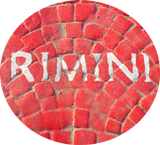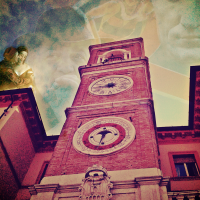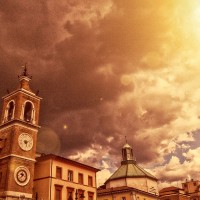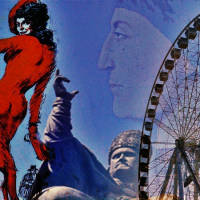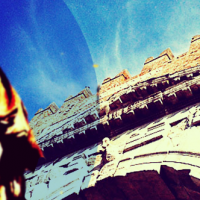Piazza Tre Martiri
Piazza Tre Martiri
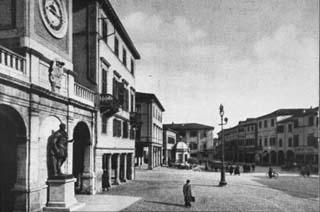 Piazza Tre Martiri is the heart of Rimini – its main square, and the scene of some of its most historic moments. It’s changed its name several times, but a brief walk around the piazza (not quite a square – more an eye-like oval) shows a continuity between Roman Ariminum and the modern city, with plenty of interesting links to the past on display.
Piazza Tre Martiri is the heart of Rimini – its main square, and the scene of some of its most historic moments. It’s changed its name several times, but a brief walk around the piazza (not quite a square – more an eye-like oval) shows a continuity between Roman Ariminum and the modern city, with plenty of interesting links to the past on display.
The Roman Forum, and Julius Caesar
The roman colony of Ariminum founded in 268 B.C had as it’s forum area the space that we now call Piazza Tre Martiri. Ariminum followed classic roman town planning concepts, having two main streets – the cardo (running on a north south axis, and corresponding to modern day Via Garibaldi and Via IV Novembre) and the decumanus (running on the east west axis, and corresponding to the modern day Corso d’Augusto), with a forum at the point where the two intersect. The forum’s role was similar to that of the Piazza in modern Italy, acting as a central place for events and important buildings.
Popular tradition (at least in Rimini!) has it that Ariminum’s forum was the scene for Julius Caesar’s famous speech to his soldiers on the 10th of January 49 B.C, after having crossed the Rubicon, when he uttered the words “alea jacta est”, or “the die is cast”. The Rubicon in this period marked the border between Rome and what was known as Cisalpine Gaul (Northern Italy). Military commanders like Caesar were expressly forbidden from leading armies into Rome, for obvious reasons. When Caesar crossed the Rubicon river, he effectively declared war on the senate.
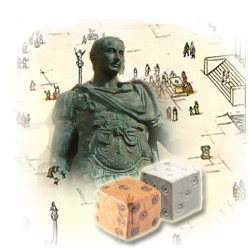 Suetonious describes the scene of Caesar rousing his troops, but deciding on the location has been difficult, as the Rubicon somehow got lost over the centuries. Amazing as it sounds, the exact location of this border river has been the subject of scholarly investigation and controversy, up until the early 1990’s when it’s location was formally identified by Italian experts as the river fiumicino which passes through the small town of Savvignano (12km from Rimini). The river, along with many others in the Po river plain, had changed course many times over the centuries due to flooding. Given that Ariminum was the gateway to Cisalpine gaul, and the largest city close to the Rubicon, it makes sense (though there’s no direct evidence) to suggest that this event would have happened here. In any case, for centuries the event was commemorated here, with the Piazza being named Piazza Giulio Cesare, and in the 16th century a plinth was erected in the spot where Caesar allegedly addressed his troops. In the corner of the modern square there’s a modest statue pointing Rome-wards.
Suetonious describes the scene of Caesar rousing his troops, but deciding on the location has been difficult, as the Rubicon somehow got lost over the centuries. Amazing as it sounds, the exact location of this border river has been the subject of scholarly investigation and controversy, up until the early 1990’s when it’s location was formally identified by Italian experts as the river fiumicino which passes through the small town of Savvignano (12km from Rimini). The river, along with many others in the Po river plain, had changed course many times over the centuries due to flooding. Given that Ariminum was the gateway to Cisalpine gaul, and the largest city close to the Rubicon, it makes sense (though there’s no direct evidence) to suggest that this event would have happened here. In any case, for centuries the event was commemorated here, with the Piazza being named Piazza Giulio Cesare, and in the 16th century a plinth was erected in the spot where Caesar allegedly addressed his troops. In the corner of the modern square there’s a modest statue pointing Rome-wards.
In Roman times the square would have been paved with large rectangular slabs (some remains of which can be seen today in the square in fenced off holes).
The Middle Ages
The axis of power shifted somewhat in the middle ages, with significant palaces for the city’s administration being built in what is now known as Piazza Cavour. For example, the Palazzo dell’Arengo, which was built by the city Mayor Mario de’Carbonesi between 1204 and 1207. With the rise to power of Sigismondo Malatesta, the administration of the city moved further, into his still-impressive Castel Sismondo.
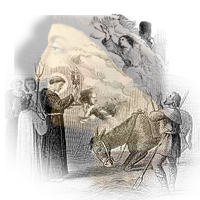 The move of administrative importance away from the area of Piazza Grande (as it was then known) doesn’t suggest, though, a change in its central position during this period. The square remained the largest in the city, and was used for big public events, for example horse races, dances, markets, and public shows. Various merchants set up shop on the far side of the square, while on the seaward side it was also the scene for the beccherie or butchers’ shops selling meat. Its importance could only have been enhanced by the construction of Sigismondo’s pride and joy, the Tempio Malatestiana in the nearby street nowadays known as Via IV Novembre.
The move of administrative importance away from the area of Piazza Grande (as it was then known) doesn’t suggest, though, a change in its central position during this period. The square remained the largest in the city, and was used for big public events, for example horse races, dances, markets, and public shows. Various merchants set up shop on the far side of the square, while on the seaward side it was also the scene for the beccherie or butchers’ shops selling meat. Its importance could only have been enhanced by the construction of Sigismondo’s pride and joy, the Tempio Malatestiana in the nearby street nowadays known as Via IV Novembre.
In the 16th Century the square underwent significant alterations and building work. It was during this period that the bell tower,Torre dell’Orologio still visible (though reconstructed several times, the last being in the 1930s). The clock face, which includes a solar/lunar calendar dates from 1750.
On the other side of the square, towards the Arco d’Augosto, is the Santuario of Saint Anthony of Padua, a small chapel built in 1518 (though reconstructed in 1672). The chapel is, according to legend, built on the spot where the famous miracle of the mule occured. The story goes that a mule kneeled down in the middle of the town, and refused to budge, or eat any oats placed before it for three days, until St.Anthony showed the blessed sacrament, at which point the mule happily headed on its way. Other towns that have claimed this miracle include Toulouse, Wadding, and Bruges, but according to the Catholic encylopedia ‘the real place, however, was Rimini’.
A grisly past
Given that Piazza Tre Martiri was/is the main square for public events, it’s no surprise that it has been the scene of some darker episodes over the centuries.
For example, Piero Meldini recounts – in his fascinating book Tenebrosa Rimini (Dark Rimini) – the story of Vaccarina, who was burned at the stake in Piazza Sant’Antonio, the modern-day Piazza Tre Martiri.
Little is known about this woman, apart from the fact that she was accused of witchcraft, and suffered the consequences. The years around 1587 were marked by particularly harsh winters, and poor harvests. This had a telling effect on the local economy, with more than 1,500 vagabonds being counted out of a population of just 9,000 according to Meldini. In such a climate a strange old woman could easily find herself under accusation of being a strega or witch.
Changing Names
The square, dating back to Roman times, has undergone quite a number of name changes. It started as the Forum of the city, and was later refered popularly to as Piazza Grande. After the construction of the chapel dedicated to St Anthony it became known as Piazza Sant’Antonio. It has also been called, in it’s time, campo del Foro (during the middle ages, many of the squares were known as campo rather than piazza, as they are still known today in Venice), and Piazza dell’Erbe. It’s most famous and enduring name, though, was Piazza Giulio Cesare. If you look around the square, though, the statue of Julius Caesar which commemorates his historic presence here is tucked in a corner, almost hidden. A curious way to treat a figure and event of huge historical importance? Well, the answer lies with a famous Romagnolo – Benito Mussolini ( he was born in Predappio, a small town in the mountains outside Forli). Mussolini spent much of his political career resurecting the myths of Roman imperial greatness, and so obviously was taken with Ariminum‘s forum. Indeed, Mussolini, when in power gifted a statue of Caesar to the city (not the one which currently stands in the corner). Since the fall of fascism, there has been an understandable wish to distance public places from any association with fascism, and given that Caesar’s historic march on Rome was echoed by Mussolini’s blackshirts, it’s hardly a surprise that Caesar is almost hidden here – particularly when one learns of the events that led up to the final renaming of the square
The Three Martyrs
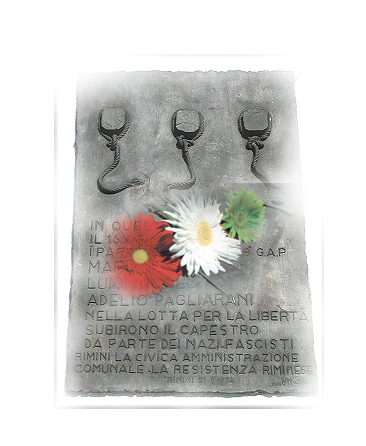 In september 1943, after the fall of Mussolini, and the signing of an armistice with the allies, Italy found itself effectively invaded by its former allies the Nazis, who managed to keep control of almost half of the country. While the allies fought to advance up through Italy between 1943 and 1944, groups of armed resistance to the Nazi’s (and the significant number of fascist loyalists) formed – the Partisans or Partigiani as they’re known in Italian.
In september 1943, after the fall of Mussolini, and the signing of an armistice with the allies, Italy found itself effectively invaded by its former allies the Nazis, who managed to keep control of almost half of the country. While the allies fought to advance up through Italy between 1943 and 1944, groups of armed resistance to the Nazi’s (and the significant number of fascist loyalists) formed – the Partisans or Partigiani as they’re known in Italian.
By the summer of 1944 the German defensive line against the allies was south of Rimini. Partisan efforts to attack the Nazi invaders concentrated primarily on sabotage efforts at this stage (though in April 1945 it would be the Partisans uprising in cities like Bologna, Milan and Turin, which would effectively liberate the country). In particular around Rimini efforts were aimed at disrupting food harvests, to stop valuable grain being shipped to Germany as part of the war effort.
It was in this context that three young Partisans, Luigi Nicolò, Adelio Pagliarani, Mario Capelli, sabotaged a threshing machine outside Rimini in August of 1944. It was an act of defiance for which they would pay dearly. The three were caught in a raid in Rimini, imprisoned and tortured, and three days later, on the 16th of August 1944 were hanged publicly in Piazza Giulio Cesare.
This barborous act is commemorated today both in the name of the Piazza, and in two commemorative plaques in the square. The plaques blend into the square, and so are easy to miss, but if you head to the corner where the Piazza meets Via IV Novembre, you’ll see a plaque with three nooses on the wall. Turn around, and close by in the paving stones is a marker which shows where the scaffolding was placed to hang the young men.
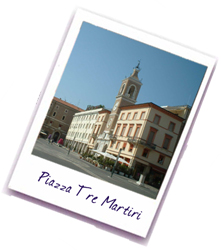 Each year, on the anniversary of their deaths, these three young men are commemorated by the local branch of the Italian Partisan’s Association A.N.P.I. with the laying of a wreath on this site. In recent years A.N.P.I. have also organised concerts – held in the nearby Corte degli Agostiniani – in their memory.
Each year, on the anniversary of their deaths, these three young men are commemorated by the local branch of the Italian Partisan’s Association A.N.P.I. with the laying of a wreath on this site. In recent years A.N.P.I. have also organised concerts – held in the nearby Corte degli Agostiniani – in their memory.
Today’s Square
Piazza Tre Martiri remains at the heart of Rimini’s commercial and cultural life. It has a wide range of shops and cafes, as well as the offices of the local newspaper. The square continues to stage public events, and seasonal markets – but most of all, it’s a hub where people meet, and a great place to watch Rimini life go by.
